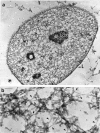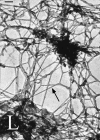Long non-coding RNAs: roles in cellular stress responses and epigenetic mechanisms regulating chromatin
- PMID: 38773934
- PMCID: PMC11123517
- DOI: 10.1080/19491034.2024.2350180
Long non-coding RNAs: roles in cellular stress responses and epigenetic mechanisms regulating chromatin
Abstract
Most of the genome is transcribed into RNA but only 2% of the sequence codes for proteins. Non-coding RNA transcripts include a very large number of long noncoding RNAs (lncRNAs). A growing number of identified lncRNAs operate in cellular stress responses, for example in response to hypoxia, genotoxic stress, and oxidative stress. Additionally, lncRNA plays important roles in epigenetic mechanisms operating at chromatin and in maintaining chromatin architecture. Here, we address three lncRNA topics that have had significant recent advances. The first is an emerging role for many lncRNAs in cellular stress responses. The second is the development of high throughput screening assays to develop causal relationships between lncRNAs across the genome with cellular functions. Finally, we turn to recent advances in understanding the role of lncRNAs in regulating chromatin architecture and epigenetics, advances that build on some of the earliest work linking RNA to chromatin architecture.
Keywords: Building RNA structures; RNP networks; chromatin architecture; genome-wide lncRNA screens; lncRNA; stress response.
Conflict of interest statement
No potential conflict of interest was reported by the author(s).
Figures




Similar articles
-
Long noncoding RNAs in lipid metabolism.Curr Opin Lipidol. 2018 Jun;29(3):224-232. doi: 10.1097/MOL.0000000000000503. Curr Opin Lipidol. 2018. PMID: 29553997 Free PMC article. Review.
-
Long non-coding RNAs and chromatin modifiers: their place in the epigenetic code.Epigenetics. 2014 Jan;9(1):21-6. doi: 10.4161/epi.27472. Epub 2013 Dec 13. Epigenetics. 2014. PMID: 24335342 Free PMC article. Review.
-
Nuclear lncRNAs as epigenetic regulators-beyond skepticism.Biochim Biophys Acta. 2014 Mar;1839(3):215-22. doi: 10.1016/j.bbagrm.2013.10.009. Epub 2013 Nov 5. Biochim Biophys Acta. 2014. PMID: 24200874 Review.
-
Comprehensive analysis of long noncoding RNA (lncRNA)-chromatin interactions reveals lncRNA functions dependent on binding diverse regulatory elements.J Biol Chem. 2019 Oct 25;294(43):15613-15622. doi: 10.1074/jbc.RA119.008732. Epub 2019 Sep 4. J Biol Chem. 2019. PMID: 31484726 Free PMC article.
-
Mechanisms of epigenetic regulation of transcription by lncRNAs in plants.IUBMB Life. 2023 May;75(5):427-439. doi: 10.1002/iub.2681. Epub 2022 Oct 27. IUBMB Life. 2023. PMID: 36222018 Review.
Cited by
-
Lead Induces Mitochondrial Dysregulation in SH-SY5Y Neuroblastoma Cells via a lncRNA/circRNA-miRNA-mRNA Interdependent Networks.Int J Mol Sci. 2025 Jul 17;26(14):6851. doi: 10.3390/ijms26146851. Int J Mol Sci. 2025. PMID: 40725099 Free PMC article.
-
Noncoding RNAs in nuclear organization.Nucleus. 2025 Dec;16(1):2477848. doi: 10.1080/19491034.2025.2477848. Epub 2025 Mar 13. Nucleus. 2025. PMID: 40083045 Free PMC article. No abstract available.
-
Deciphering the epigenetic role of long non-coding RNAs in mood disorders: Focus on human brain studies.Clin Transl Med. 2025 Mar;15(3):e70135. doi: 10.1002/ctm2.70135. Clin Transl Med. 2025. PMID: 40038891 Free PMC article. Review.
-
Pseudogene: Relevant or Irrelevant?Biomed J. 2025 Jun;48(3):100790. doi: 10.1016/j.bj.2024.100790. Epub 2024 Sep 19. Biomed J. 2025. PMID: 39305992 Free PMC article. Review.
-
Role of lncRNAs in pathophysiology of obesity.Curr Opin Physiol. 2025 Jun;44:100832. doi: 10.1016/j.cophys.2025.100832. Epub 2025 May 8. Curr Opin Physiol. 2025. PMID: 40823284
References
-
- Abe R, Yagi Y, Tani H. Identifying long non-coding RNA as potential indicators of bacterial stressin human cells. BPB Reports. 2023;6(6):226–228. doi: 10.1248/bpbreports.6.6_226 - DOI
Publication types
MeSH terms
Grants and funding
LinkOut - more resources
Full Text Sources
